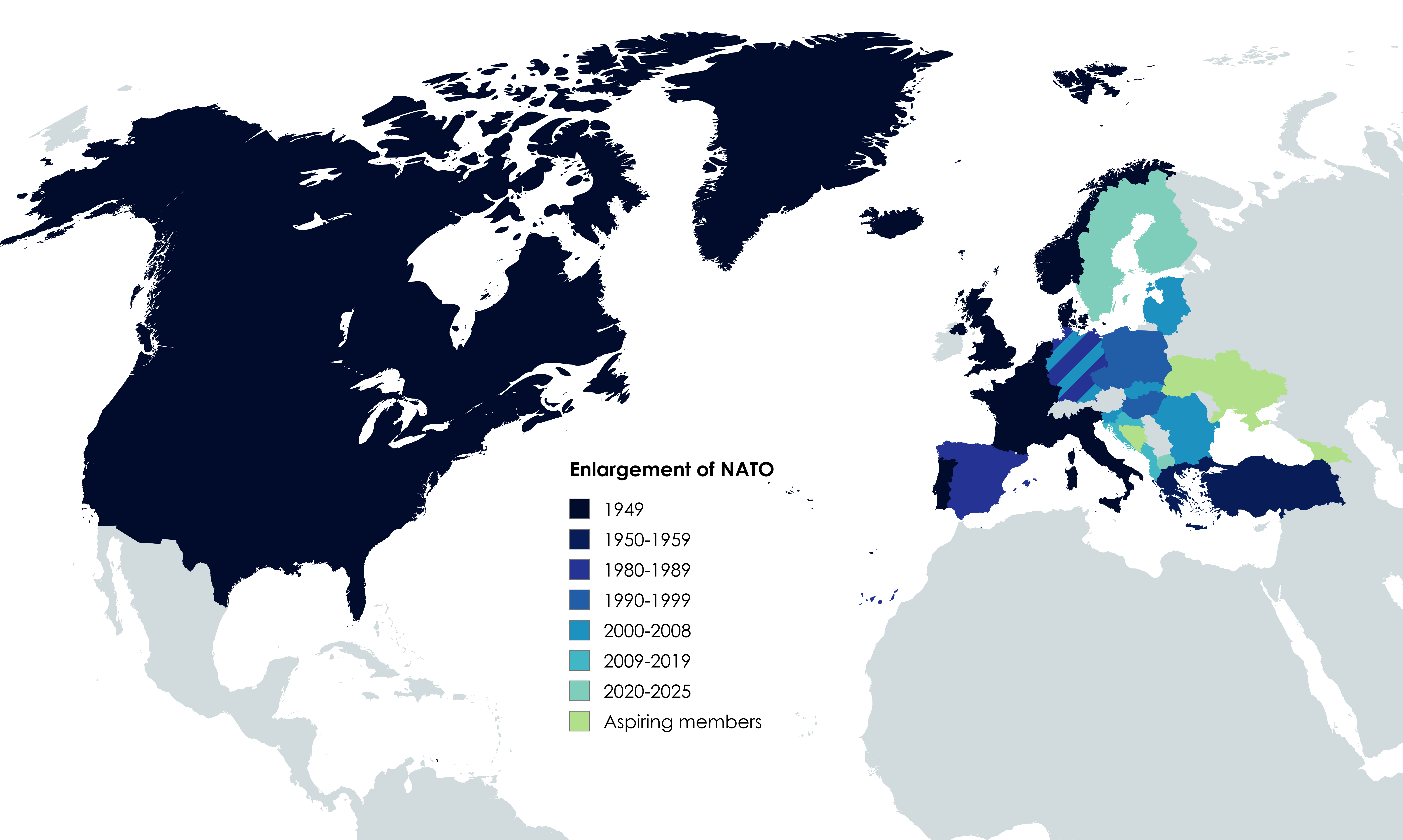NATO Enlargement Map


Marcus Rodriguez
Historical Geography Expert
Marcus Rodriguez specializes in historical cartography and geographic data analysis. With a background in both history and geography, he brings unique...
Geographic Analysis
What This Map Shows
This map illustrates the expansion of the North Atlantic Treaty Organization (NATO) from its inception in 1949 to its most recent member additions. You can see how NATO has gradually increased its membership, reflecting changes in geopolitical dynamics and security concerns in Europe and beyond. The map highlights countries that joined NATO over the decades, showcasing not just a geographical spread but also the shifting alliances and defense strategies in response to various historical events, notably the end of the Cold War and the ongoing tensions with Russia.
Deep Dive into NATO Enlargement
NATO, founded in the aftermath of World War II, was created to provide collective defense against aggression, particularly from the Soviet Union. Initially, it included just twelve founding members: the United States, Canada, Belgium, Denmark, France, Iceland, Italy, Luxembourg, the Netherlands, Norway, Portugal, and the United Kingdom. The first significant enlargement occurred in 1952, with Greece and Turkey joining, which highlighted NATO's interest in extending its influence in the Mediterranean and Southeast Europe.
However, the most profound changes began after the collapse of the Soviet Union in 1991. Countries in Central and Eastern Europe sought security assurances against potential Russian aggression, leading to a wave of accessions. Poland, Hungary, and the Czech Republic joined in 1999, marking the first post-Cold War enlargement. By 2004, NATO's membership had expanded dramatically to include seven additional countries: Bulgaria, Estonia, Latvia, Lithuania, Romania, Slovakia, and Slovenia.
What’s fascinating is that NATO's enlargement is not just a matter of numbers; it has significant implications for international relations. For instance, the inclusion of the Baltic states (Estonia, Latvia, and Lithuania) has been particularly contentious, given their proximity to Russia. NATO’s presence in these areas has been viewed as a deterrent against possible aggression from Moscow, especially in light of events like the annexation of Crimea in 2014.
The NATO enlargement map illustrates not only the geographical aspect but also the evolving security landscape in Europe. Countries like Montenegro joined in 2017 and North Macedonia in 2020, signaling NATO's ongoing commitment to include nations that seek a collective defense framework. However, there remain several countries, such as Ukraine and Georgia, who aspire to membership but face significant hurdles due to ongoing conflicts and Russia's strong opposition.
Regional Analysis
Looking closely at the regions represented on the map, we can see distinct patterns of NATO membership and regional security dynamics. Western Europe has long been a stronghold for NATO, with founding members largely concentrated in this area. The alliance has played a crucial role in maintaining stability in Western Europe since WWII.
In Central and Eastern Europe, the map reveals a stark difference. The post-1991 wave of enlargement represents countries that once fell under Soviet influence, illustrating a shift towards Western alignment and democratic governance. For example, the Baltic states not only sought NATO membership for security but also to solidify their independence from Russia. The map, thus, highlights not just a military alliance but a broader ideological commitment to democracy and rule of law.
Interestingly, the Balkans also present a varied scenario. Countries like Albania and Croatia, which joined in 2009, have had to navigate complex historical tensions and ethnic divisions to align with NATO's standards. This region's path to NATO membership underscores the alliance's role not only in defense but also in promoting stability and cooperation.
Significance and Impact
The significance of NATO enlargement cannot be overstated. It shapes the geopolitical landscape of Europe and poses implications for global security dynamics. As NATO continues to expand, it also faces criticism and challenges, particularly from Russia, which views the alliance's growth as a direct threat to its sphere of influence.
In terms of real-world implications, NATO's enlargement has led to increased military cooperation among member states, joint exercises, and a more unified defense policy. However, it has also heightened tensions in regions like Eastern Europe, where Russia feels encircled. The ongoing war in Ukraine exemplifies the delicate balance of power that NATO must navigate.
Looking to the future, the map of NATO enlargement will likely evolve further, with potential new members seeking protection and solidarity against perceived threats. The dynamics of global security are constantly changing, and NATO's role will be crucial in addressing these challenges. One can only wonder how the map will look in the coming decades as new countries join and existing members adapt to shifting geopolitical landscapes.
Visualization Details
- Published
- September 12, 2025
- Views
- 74
Comments
Loading comments...